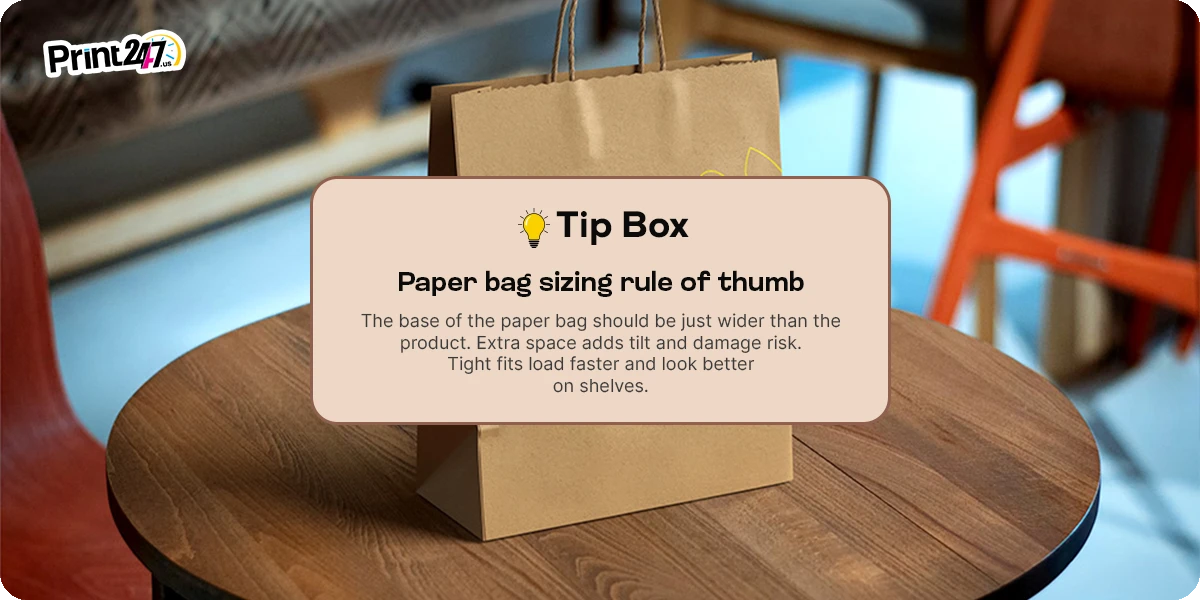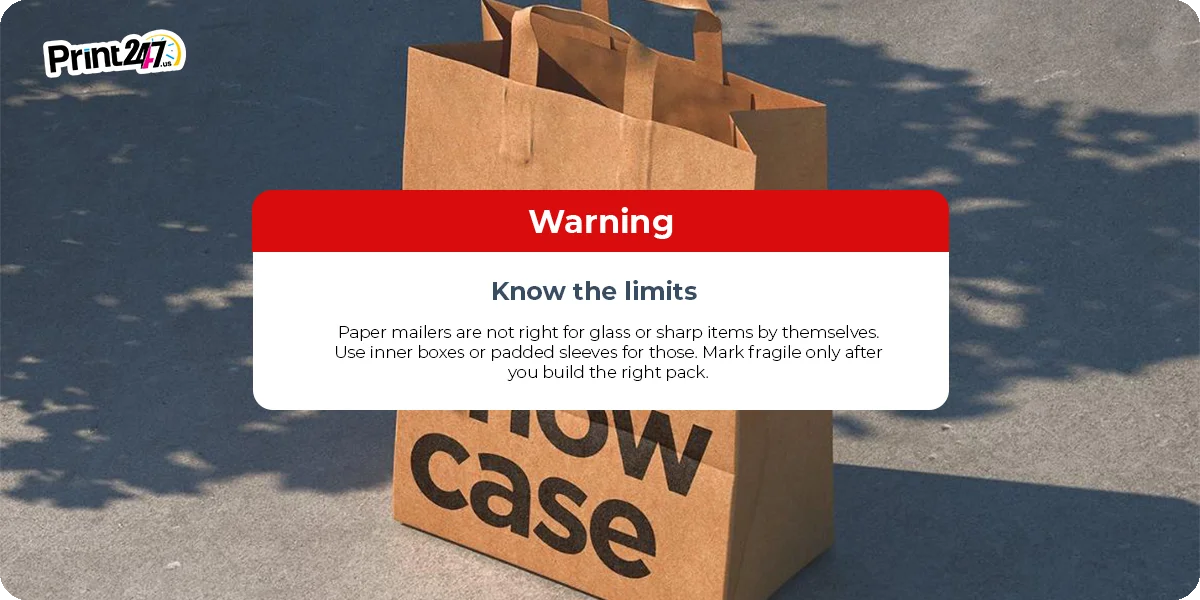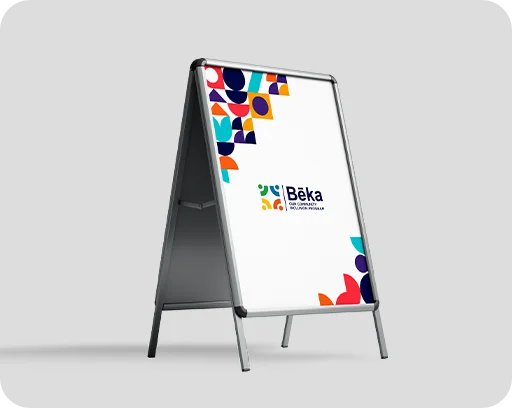Top 10 Types of Paper Bags and Their Practical Uses Explained
.jpg)
Paper bags come in many types, each made for a clear job. Most use kraft or recycled paper with options like windows, grease resistance, or rope handles. Pick strength, base style, and size based on product weight, shipping needs, and look. This guide explains the top types and real uses.
Paper bags were introduced in the 19th century by Francis Wolle. From then to now, they have been the go-to option in the packaging industry. There is more to choosing a paper bag than just its appearance. This affects the speed of service at the counter, shipping waste, damage rates, and the way shoppers view your brand.
Paper bags in general are made by shaping kraft or recycled paper into tubes with gussets and bases and carrying products safely in them. The long answer depends on weight, size, barrier, and handle strength.
In this guide, we break down the top 10 types of paper bags for business use. Here, we are going to discuss paper bag properties, paper bag material choices, and where each style shines.
Use this as a quick, plain guide to match bag type, cost, and function to your line, whether you are a grocery, bakery, fashion label, coffee roaster, or fast-growing eCommerce brand.
Let’s start.
Key Takeaways:
Paper bag types differ by paper grade, base style, handle, and barrier.
Kraft paper is strong, tear resistant, and great for daily retail.
Flat-bottom bags stand on their own and speed packing lines.
Gift and euro totes boost brand look for retail and events.
Pinch bottom styles suit dry mixes, coffee, and tea.
Mailing paper bags cut plastic use for soft goods shipping.
Recycled content supports ESG goals and local rules.
Bakery bags need grease resistance and breathability.
Vogue bags give tall space for branding and apparel.
Handmade luxury bags fit high-ticket goods and short runs.
1 - Custom Brown Kraft Bags
Custom brown kraft bags are the everyday carry workhorses. The brown look comes from unbleached kraft fiber. Typical weights range from 80 to 150 gsm for standard retail, with higher gsm for heavy goods. The fibers are long and give strong tear resistance. Handle options include twisted paper for daily use, flat paper for budget needs, and rope for added comfort. Printing is usually flexo or digital. You can add simple one or two color art for a clean, eco-forward look.
Brown kraft paper bag properties include high burst strength, good tear resistance, reliable gusset strength, and easy recycling in many cities. If clients ask what are brown paper bags made of, the answer is unbleached kraft that can include recycled content.
Here are some use cases of these paper bags:
Grocery and meal prep pickups
Hardware and farm supply for small heavy goods
Breweries and bottle shops using thicker grades
Roll out gsm according to the heaviest item in your top three products. Make sure there is a base board for glass or jars. Keep art minimal for faster turn and lower cost. Use gusset space for store hours, return policy, or recycling tips. For shipping, place bagged orders inside cartons to avoid crushing in transit.
2 - Flat-bottom Paper Bags (SOS Bags)
The flat-bottom paper bags, also called block bottom bags or SOS bags, stand on their own. The square or rectangular base of these bags spreads weight so jars, candles, and small boxes do not tip. Paper choices include brown or white kraft from 70 to 150 gsm. Options include windows, grease resistance, and zip ties.
Properties of a paper bag with a flat base include table shelf presence, fast loading, and better bin stacking. If you get asked what flat bottom paper bags are made out of, the answer is kraft with optional liners or coatings.
Here are some SOS bags use cases:
Coffee and tea with valves or tin ties
Snacks and candy with windows for display
Beauty and wellness bars, bombs, and soaps
Hardware parts and small box kits
A few tips when rolling out include: size the base to the product footprint with 0.25 inch slack for tissue. If you need heat sealing, choose a paper poly bag built with a thin inner layer that seals on standard heat bars. Print ingredients and compliance on the side gusset. Keep the front clean for brand and flavor callouts.

3 - Gift paper bags
The goal of gift paper bags is to create a clean and festive appearance. To create a smooth surface, they use white or dyed paper that weighs between 120 and 180 grams. There are several types of handles that you can attach with gift paper bags, such as ribbons, ropes, and cotton. Laminate or coat the product lightly to prevent scuffs. Buyers seeking gift bags with color hold, crisp folds, and a sturdy base should consider color hold, crisp folds, and a sturdy base.
Here are some practical use cases of gift paper bags:
Jewelry and small luxury goods in compact sizes
Corporate gifting kits with tissue and postcards
Beauty and spa bundles for holidays and events
Pop-up shops and seasonal campaigns
Tips for launching: choose a core size set that maps to your kits. Keep colors in your brand palette so leftover stock still works next season. Use digital print for short runs and variable QR codes to track store-level lift. Place care steps or return policy inside the bag for a tidy outside look.
4 - Euro tote bags
Euro tote bags are premium retail carriers with thick paper, turned tops, rope or ribbon handles, and reinforced boards. Brands and retailers use these bags for premium customer experience. Paper is often coated or art paper at 170 to 250 gsm. Many brands add soft touch, foil, or spot gloss. Eyelets protect the handle holes, and base cards handle weight. These paper bags are made of high grade paper, board reinforcements, and textile handles that feel solid in hand.
Here are some euro tote bag uses:
Fashion and footwear stores
Tech and electronics with device boxes
Trade shows for catalogs and samples
Premium wine and gourmet shops
Check handle knots and base strength at two times the typical load. Keep art simple and bold for visibility in photos and at doors. Use inside print for surprise and for anti-swap notes. Pick a few standard sizes to cut lead times and cost.
5 - Pinch Bottom Paper Bags
Pinch bottom paper bags have a V-fold base that seals flat after filling. They are classic for dry goods such as coffee, tea, flour, spices, and pet treats. Paper options include kraft or clay-coated paper. Seal the bag with a glassine or thin film liner if needed. The reclosure of the package is made easier by tin ties or zippers.
Some renowned pinch bottom paper bag properties include a good sift control for fine powders, clean front panels for labels, and a slim profile for peg hooks. When clients ask how paper bags are made for this style, they use tube forming, side gussets, and a heat or adhesive pinch to close the bottom.
A few practical uses of these bags will help you understand them more clearly.
Coffee roasters using 250 g and 1 lb
Baking mixes and spice packs
Pet treats and small snack lines
Wellness powders that need reclose zips
When it comes to rollout tips, select a paper poly bag made with a thin inner layer for seal strength. You can add valve options for coffee in pinch bottom paper bags. You should keep dates and batch codes clear on the gusset. Test sift with your finest powder to confirm seam hold.
6 - Mailing Paper Bags
Mailing paper bags are one of the common types of paper bags. These are often called paper mailers, serve eCommerce shipping for soft goods and boxed items. They use heavy force along with a peel-and-seal strip and sometimes a second strip for returns. Many sizes are flat. Some have side gussets for small boxes or kits. The materials for paper mailer include a tough kraft with strong seams and a tear strip.
Here is a list of brands that use these bags.
Bookstores and publishers sending single books
Beauty brands shipping boxed sets in gusseted mailers
Brands with high return rates using double seal strips
Apparel brands shipping tees, joggers, and hoodies
If you’re going to choose these paper bags, then opt for the smallest size that fits to cut dim weight. You can protect sharp corners by using honeycomb wrap or a thin box insert. Put return instructions on the back flap. Add a moisture card inside during wet seasons.

7 - Recycled Paper Bags
Recycled paper bags use post-consumer or post-industrial fiber. Many cities set minimum recycled content for carry bags. These look like standard kraft but show recycled percentages on the base. Compared to plastic bags, these bags are significantly more biodegradable. In contrast, plastic bags decompose over hundreds of years.
Recycling paper bags have slightly lower burst at the same gsm, but are still strong enough for retail. You will observe a sense of warmth and naturalness to the print. Texture has tiny specks that signal eco care.
Here are some practical use cases of recycled paper bags.
Chains with ESG targets and store signage
Grocery and food service seeking eco messaging
Events and pop-ups using quick local supply
Brands that want a uniform look with an eco story
Always match gsm to the weight of your heaviest common order before roll out. You can use twisted handles with strong knots. It would be better to print a recycling callout on the gusset. Balance recycled content with performance by testing a few gsm levels with your real items.
By 2035, the global recycled paper bags market is expected to expand from USD 5 billion to USD 7 billion, with a CAGR of 3.4% during the forecast period. (Source: FactMr)
8 - Bakery Paper Bags
Bakery paper bags cover simple sleeves, glassine, and grease resistant builds. They protect cookies, donuts, breads, muffins, and pastries from smears. Windowed versions show products while keeping hands off. The key is breathability and grease holdout. Glassine gives a smooth, semi see-through feel. These bags enhance the bakery experience and take the food business to the next level.
The paper bags have grease-resistant folds, crumb control, and enough space for labels that will stay on even when there is oil present.
Bakery paper bags practical uses:
Bakeries serving cookies and pastries at speed
Cafes using tall baguette sleeves with vent holes
Grocery in-store bakeries with windowed muffin bags
Catering with printed reheating tips on gussets
Before going with these types of paper bags, match grease rating to your oiliest item to avoid bleed. Standardize two or three core sizes to keep lines moving. Plan blank label zones for flavor, date, and allergen notes. For warm items, add small vents so steam can exit.
9 - Vogue Paper Bags
Vogue paper bags are tall, slim retail carriers that sit between gift bags and euro totes. They use white or dyed kraft from about 120 to 170 gsm with ribbon or soft cord handles. They hold apparel boxes, cosmetic kits, and small shoes while giving large print areas. The properties of vogue paper bags are tall panels for branding, strong creases that hold shape, and base cards that don't bow.
Here’s the list of businesses that use these vogue bags.
Apparel brands packing folded garments and kits
Beauty and hair care with boxed tools and sets
Duty-free and event pop-ups sending attendees home with samples
Gift shops needing premium look at lower cost than euro totes
To roll out these bags for successful launch, keep art minimal for year-round use. A neutral base with one accent ink lowers cost. Use inside color for a surprise that hides scuffs. Test handle comfort with heavier loads like denim.
10 - Handmade Luxury Paper Bag
Handmade luxury paper bags are built with high care for premium goods. They offer a great way for you to reinforce your brand identity with personalized branding. These types of bags use thick paper, turned edges, reinforced tops and bases, and sewn or glued handles. Finishes can include soft touch, linen texture, emboss, and foil. Short runs allow custom sizes for unique items.
What are paper bags properties here? Perfect folds, strong handle mounts, rich color depth, and a rigid base that resists crush.
This luxury paper bag can be used for a variety of purposes. Here are some of them.
Jewelers and watch sellers with fitted boxes
Luxury apparel and footwear with heavy items
VIP and influencer kits with custom inserts
Wine and spirits using bottle sizes with padded bases
Before launch, get a sample first to lock color and fit. Run a weight test at twice the expected load. Add a pocket inside for receipts or care cards. Use small print runs for seasonal events, then keep a core look in stock year round.
Conclusion
A smart paper bag strategy starts with product weight, size, and flow. Then match paper grade, base style, handle type, and any barrier you need. Keep sizes tight, add base cards for heavy items, and place clear info on gussets. If you want fast help with sizing, art, and samples, buy from Print247, the leading custom packaging supplier in the United States. You get free paper bag design support, eco friendly materials, fast shipping, and physical samples to test before a big roll out. Your team packs faster, your goods travel safer, and your brand looks sharp in every hand.
FAQs
What handle type lasts longest for daily retail use in paper bags?
Twisted paper handles are strong, cost effective, and recycle friendly. Rope handles feel premium but cost more. For heavy items, reinforce the top fold, use proper knots or eyelets, and add a base board. Test with double the expected load for safety.
What is the best paper bag type for oily baked goods?
Pick bakery bags with higher grease resistance or glassine. Windowed styles help sell while keeping hands off the product. Add vent holes for heat to escape if you bag warm items. Test with your oiliest product to avoid bleeding through.
Do recycled paper bags affect print quality?
Recycled fiber can show a warmer tone and small specks, which many brands like. Modern presses handle line art and solid logos well. If you need very fine gradients, request print tests. Balance recycled content with gsm and handle choice to keep strength.
How do I plan sizes for euro totes across many stores?
Make a ladder that covers small accessories, folded apparel, and larger boxes. Reduce cost and speed by standardizing two or three sizes. Use reinforced base cards, rope handles, and turned tops. Keep artwork simple so the same bags work for many seasons.


















































.jpg)
.jpg)
.jpg)